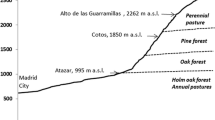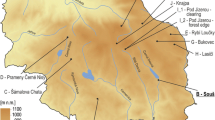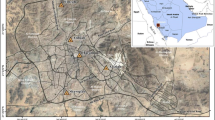Abstract
Purpose
We aimed to investigate the spatial O3 indices (SOMO35: annual sum of maximum daily 8-h ozone means over 35 ppb, AOT40: the accumulated exposure over an hourly threshold of 40 ppb during daylight hours between 8:00 and 20:00 in the growing seasons of plants) in Tehran (2019–2020).
Methods
The data of ambient O3 concentrations, measured at twenty-three regulatory ambient air quality monitoring stations (AQMSs) in Tehran, were obtained.
Results
The annual mean O3 concentrations were found to be 15.8–25.7 ppb; the highest and lowest annual mean concentration of ambient O3 were observed in Shahrdari 22 and Shahr-e-Rey stations, respectively. Spatial distribution of exposure to O3 across Tehran was in the range of 1.36–1.64; the highest O3 concentrations were observed in the northern, west and south-western parts of Tehran, while the central and south areas of Tehran city experienced low to moderate concentrations. The indices of SOMO35, AOT40f and AOT40v across AQMSs in Tehran was in the range of 1830–6437 ppb. Days, 10,613–39,505 ppb.h and 4979–16,804 ppb.h, respectively. For Tehran city, the indices of SOMO35 and AOT40f were 4138 ppb. days and 27,556 ppb.h respectively. Our results revealed that the value of SOMO35 across AQMSs of Tehran was higher than the recommended target value of 3000 ppb. days.
Conclusions
To reduce O3 pollution and its effects on both human and plants health, the governmental organizations should take appropriate sustainable control policies.






Similar content being viewed by others
Data availability
All data generated or analysed during this study are included in this published article.
References
Feng Z, De Marco A, Anav A, Gualtieri M, Sicard P, Tian H, et al. Economic losses due to ozone impacts on human health, forest productivity and crop yield across China. Environ Int. 2019;131:104966.
Ramos Y, Requia WJ, St-Onge B, Blanchet J-P, Kestens Y, Smargiassi A. Spatial modeling of daily concentrations of ground-level ozone in Montreal, Canada: a comparison of geostatistical approaches. Environ Res. 2018;166:487–96.
Agathokleous E, Araminiene V, Belz RG, Calatayud V, De Marco A, Domingos M, et al. A quantitative assessment of hormetic responses of plants to ozone. Environ Res. 2019;176:108527.
Ezimand K, Kakroodi A. Prediction and spatio–temporal analysis of ozone concentration in a metropolitan area. Ecol Indic. 2019;103:589–98.
Qiao X, Wang P, Zhang J, Zhang H, Tang Y, Hu J, et al. Spatial-temporal variations and source contributions to forest ozone exposure in China. Sci Total Environ. 2019;674:189–99.
Liu H, Zhang M, Han X, Li J, Chen L. Episode analysis of regional contributions to tropospheric ozone in Beijing using a regional air quality model. Atmos Environ. 2019;199:299–312.
Faridi S, Shamsipour M, Krzyzanowski M, Künzli N, Amini H, Azimi F, et al. Long-term trends and health impact of PM2. 5 and O3 in Tehran, Iran, 2006–2015. Environ Int. 2018;114:37–49.
Liu R, Ma Z, Liu Y, Shao Y, Zhao W, Bi J. Spatiotemporal distributions of surface ozone levels in China from 2005 to 2017: A machine learning approach. Environ Int. 2020;142:105823.
Hakim, Z.Q., Archer-Nicholls, S., Beig, G., Folberth, G.A., Sudo, K., Abraham, L., Ghude, S., Henze, D. and Archibald, A. Evaluation of tropospheric ozone and ozone precursors in simulations from the HTAPII and CCMI model intercomparisons–a focus on the Indian subcontinent. 2019.
Hadei M, Hopke PK, Nazari SSH, Yarahmadi M, Shahsavani A, Alipour MR. Estimation of mortality and hospital admissions attributed to criteria air pollutants in Tehran metropolis, Iran (2013-2016). Aerosol Air Qual Res. 2017;17:2474–81.
Wang P, Chen Y, Hu J, Zhang H, Ying Q. Source apportionment of summertime ozone in China using a source-oriented chemical transport model. Atmos Environ. 2019;211:79–90.
Garg A, Gupta N. A comprehensive study on spatio-temporal distribution, health risk assessment and ozone formation potential of BTEX emissions in ambient air of Delhi, India. Science of the Total Environment. 2019;659:1090–9.
Strode SA, Ziemke JR, Oman LD, Lamsal LN, Olsen MA, Liu J. Global changes in the diurnal cycle of surface ozone. Atmos Environ. 2019;199:323–33.
Boleti E, Hueglin C, Takahama S. Trends of surface maximum ozone concentrations in Switzerland based on meteorological adjustment for the period 1990–2014. Atmos Environ. 2019;213:326–36.
Zhang L, Hoshika Y, Carrari E, Badea O, Paoletti E. Ozone risk assessment is affected by nutrient availability: evidence from a simulation experiment under free air controlled exposure (FACE). Environ Pollut. 2018;238:812–22.
Yousefian F, Faridi S, Azimi F, Aghaei M, Shamsipour M, Yaghmaeian K, et al. Temporal variations of ambient air pollutants and meteorological influences on their concentrations in Tehran during 2012–2017. Sci Rep. 2020;10:1–11.
Heger, M. and Sarraf, M. Air pollution in Tehran: health costs, sources, and policies; World Bank, 2018.
Faridi S, Niazi S, Yousefian F, Azimi F, Pasalari H, Momeniha F, et al. Spatial homogeneity and heterogeneity of ambient air pollutants in Tehran. Sci Total Environ. 2019;697:134123.
Maji KJ, Ye W-F, Arora M, Nagendra SS. PM2. 5-related health and economic loss assessment for 338 Chinese cities. Environ Int. 2018;121:392–403.
Jafari AJ, Faridi S, Momeniha F. Temporal variations of atmospheric benzene and its health effects in Tehran megacity (2010-2013). Environ Sci Pollut Res. 2019;26:17214–23.
Yunesian M, Rostami R, Zarei A, Fazlzadeh M, Janjani H. Exposure to high levels of PM2. 5 and PM10 in the metropolis of Tehran and the associated health risks during 2016–2017. Microchem J. 2019;150:104174.
Janjani H, Hassanvand MS, Kashani H, Yunesian M. Characterizing multiple air pollutant indices based on their effects on the mortality in Tehran, Iran during 2012–2017. Sustain Cities Soc. 2020;59:102222.
Sicard P, Serra R, Rossello P. Spatiotemporal trends in ground-level ozone concentrations and metrics in France over the time period 1999–2012. Environ Res. 2016;149:122–44.
Karimi A, Shirmardi M, Hadei M, Birgani YT, Neisi A, Takdastan A, et al. Concentrations and health effects of short-and long-term exposure to PM2. 5, NO2, and O3 in ambient air of Ahvaz city, Iran (2014–2017). Ecotoxicol Environ Saf. 2019;180:542–8.
Lin Y, Jiang F, Zhao J, Zhu G, He X, Ma X, et al. Impacts of O3 on premature mortality and crop yield loss across China. Atmos Environ. 2018;194:41–7.
Li P, De Marco A, Feng Z, Anav A, Zhou D, Paoletti E. Nationwide ground-level ozone measurements in China suggest serious risks to forests. Environ Pollut. 2018;237:803–13.
Zhao H, Zheng Y, Zhang Y, Li T. Evaluating the effects of surface O3 on three main food crops across China during 2015–2018. Environ Pollut. 2020;258:113794.
Alizadeh-Choobari O, Bidokhti A, Ghafarian P, Najafi M. Temporal and spatial variations of particulate matter and gaseous pollutants in the urban area of Tehran. Atmos Environ. 2016;141:443–53.
Jahangir MS, Moghim S. Assessment of the urban heat island in the city of Tehran using reliability methods. Atmos Res. 2019;225:144–56.
Barzeghar V, Sarbakhsh P, Hassanvand MS, Faridi S, Gholampour A. Long-term trend of ambient air PM10, PM2. 5, and O3 and their health effects in Tabriz city, Iran, during 2006–2017. Sustain Cities Soc. 2020;54:101988.
Amini H, Hosseini V, Schindler C, Hassankhany H, Yunesian M, Henderson SB, et al. Spatiotemporal description of BTEX volatile organic compounds in a middle eastern megacity: Tehran study of exposure prediction for environmental health research (Tehran SEPEHR). Environ Pollut. 2017;226:219–29.
Emam B, Shahsavani A, Khodagholi F, Zarandi SM, Hopke PK, Hadei M, et al. Effects of PM 2.5 and gases exposure during prenatal and early-life on autism–like phenotypes in male rat offspring. Particle and Fibre Toxicology. 2020;17:1–16.
Faridi S, Naddafi K, Kashani H, Nabizadeh R, Alimohammadi M, Momeniha F, et al. Bioaerosol exposure and circulating biomarkers in a panel of elderly subjects and healthy young adults. Sci Total Environ. 2017;593:380–9.
Faraji M, Pourpak Z, Naddafi K, Nodehi RN, Nicknam MH, Shamsipour M, et al. Effects of airborne particulate matter (PM10) from dust storm and thermal inversion on global DNA methylation in human peripheral blood mononuclear cells (PBMCs) in vitro. Atmos Environ. 2018;195:170–8.
Hassanvand MS, Naddafi K, Kashani H, Faridi S, Kunzli N, Nabizadeh R, et al. Short-term effects of particle size fractions on circulating biomarkers of inflammation in a panel of elderly subjects and healthy young adults. Environ Pollut. 2017;223:695–704.
Taghvaee S, Sowlat MH, Hassanvand MS, Yunesian M, Naddafi K, Sioutas C. Source-specific lung cancer risk assessment of ambient PM2. 5-bound polycyclic aromatic hydrocarbons (PAHs) in Central Tehran. Environ Int. 2018a;120:321–32.
Taghvaee S, Sowlat MH, Mousavi A, Hassanvand MS, Yunesian M, Naddafi K, et al. Source apportionment of ambient PM2. 5 in two locations in Central Tehran using the positive matrix factorization (PMF) model. Sci Total Environ. 2018b;628:672–86.
Soleimanian E, Taghvaee S, Mousavi A, Sowlat MH, Hassanvand MS, Yunesian M, et al. Sources and temporal variations of coarse particulate matter (PM) in Central Tehran, Iran. Atmosphere. 2019;10:291.
Amini H, Nhung NTT, Schindler C, Yunesian M, Hosseini V, Shamsipour M, et al. Short-term associations between daily mortality and ambient particulate matter, nitrogen dioxide, and the air quality index in a middle eastern megacity. Environ Pollut. 2019;254:113121.
Bayat R, Ashrafi K, Motlagh MS, Hassanvand MS, Daroudi R, Fink G, et al. Health impact and related cost of ambient air pollution in Tehran. Environ Res. 2019;176:108547.
Hadei M, Shahsavani A, Krzyzanowski M, Querol X, Stafoggia M, Nazari SSH, et al. Burden of mortality attributed to PM2. 5 exposure in cities of Iran; contribution of short-term pollution peaks. Atmos Environ. 2020;224:117365.
Acknowledgements
The authors are grateful to Tehran Air Quality Control Company for providing ambient air pollutant concentrations data.
Funding
The present study was funded by grant number 97000507 from Health Research Center, Lifestyle Institute, Baqiyatallah University of Medical Sciences.
Author information
Authors and Affiliations
Contributions
SF and AA deigned the study. SF and HF conducted the study and gathered all data. SF and HA analyzed the data. SF drafted the manuscript. AA, HF, SK and HA revised the manuscript.
Corresponding author
Ethics declarations
Ethics approval and consent to participate
Not applicable.
Consent for publication
Not applicable.
Competing interests
The authors declare that they have no competing interests.
Additional information
Publisher’s note
Springer Nature remains neutral with regard to jurisdictional claims in published maps and institutional affiliations.
Electronic supplementary material
ESM 1
(DOCX 274 kb)
Rights and permissions
About this article
Cite this article
Faridi, S., Akbari, H., Faridi, H. et al. Human, Forest and vegetation health metrics of ground-level ozone (SOMO35, AOT40f and AOT40v) in Tehran. J Environ Health Sci Engineer 18, 1351–1358 (2020). https://doi.org/10.1007/s40201-020-00552-2
Received:
Accepted:
Published:
Issue Date:
DOI: https://doi.org/10.1007/s40201-020-00552-2




